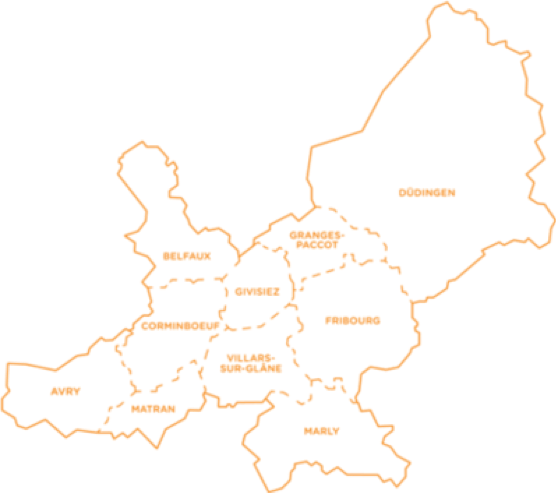Eva Maria Belser and Bernhard Altermatt, IFF Institute of Federalism, University of Fribourg
Relevance of the Practice
The process of creating the formally constituted Agglomeration of Fribourg was legally made possible with the adoption by the Canton of Fribourg, in 1995, of the innovative Law on Agglomerations (LAgg) that allowed for the creation of a fourth tier of government. Following years of increasing collaboration in areas of common interest, a group of 10 municipalities, recognizing the need for more cooperation, agreed to formalize their collaboration and to delegate their competences in the following fields: regional planning including mobility; economic promotion; promotion of tourism and of cultural activities. Aiming at a sustainable development and a mutual understanding, the institution of the politically constituted Agglomeration also promotes Fribourg’s regional bilingualism insofar as it includes the bilingual capital-city, one German-speaking commune and the majority of the city’s French-speaking neighboring municipalities.
Nine of the ten united communes in the Agglomeration of Fribourg also participate (with additional municipalities) in a merging process which has taken up speed and is heading for a consultative vote among the population in 2021. It would be highly interesting to develop on this example and compare it with other similar examples of communes cooperating in inter-communal structures or formal agglomerations and engaged in parallel merging processes.
The study of this practice is relevant for the LoGov researchers as it will allow to identify and discuss:
- factors of success or failure of communal mergers and agglomerations;
- the set of rules of inclusion/exclusion of members, in particular rural municipalities;
- the extent to which the processes reinforce or decrease the centralization of power;
- if agglomerations compete or even threaten the legitimacy of communes and cantons;
- if agglomeration processes concern only the urban areas or if there are examples in rural areas.
Description of the Practice
Originally, the citizens of five municipalities (Belfaux, Corminboeuf, Marly, Villars-sur-Glâne and Fribourg) required, in 1999, the creation of the agglomeration of Fribourg encompassing the City of Fribourg and the other four neighboring municipalities. In reaction to this formal request, the Canton of Fribourg initiated the idea of opening the circle to five other municipalities that also were in direct connection with the capital City of Fribourg. A consensus was reached and the decision was taken: the process of creating the agglomeration of Fribourg would take onboard not 5 but 10 municipalities (Grolley, Granges-Paccot, Düdingen, Tafers and Givisiez joined the initial group).
For 6 years, between 2002 and 2008, the constitutive assembly drafted the articles of association of this yet to create new political institution. In the meantime, the project raised the interest of other municipalities while others decided to withdraw from the process. The constitutive assembly integrated Avry and Matran in 2008 and accepted the withdrawing of Grolley in 2007 and Tafers in 2008. As of today (2021), the geographic composition and the political dimension of the agglomeration of Fribourg has remained unchanged.

Once the constitutive assembly had finalized the statutes of the new Agglomeration, the citizens of each municipality were invited, on 1 June 2018, to vote on their adoption. 72.5 per cent of the voters approved them while one municipality out of ten rejected them.[2]
Assessment of the Practice
Since its entry into force, the Agglomeration of Fribourg has sought to optimize the resources available and has invested in projects and infrastructures that serve the whole region instead of single municipalities. In doing so, the participating communes have adopted three so-called ‘agglomeration projects’ and have received financial support from the Confederation through the national Agglomeration Policy.
The objectives seem to have been partially met. As a forum aiming at bringing municipalities closer and fostering cooperation in specific areas of public policy (such as culture), the Agglomeration of Fribourg can certainly be seen as a success. Nevertheless, more complex and top-ranking projects such as favoring so-called «slow mobility» and extending public transportation have moved on more slowly. In addition, the institutional structure and the limited size of the agglomeration are subject to political discussions. Specifically, the Canton of Fribourg has adapted the governing legislation (Law on Agglomerations) in order to include a greater number of structurally linked communes. This adaptation will necessitate a major reform of the Agglomeration’s institutional design, including with respect to its democratic governance guaranteed, thus far, by an autonomous layer of executive and legislative bodies.
Furthermore, the Canton of Fribourg has long encouraged the full merger of the municipalities involved in the agglomeration with the City of Fribourg in order to create a larger urban center[3]. With the aim of fostering the merging process and enlarging the agglomeration with the absorption of additional, more rural, municipalities, the cantonal parliament has decided in 2020 to modify the Law on Agglomeration (LAgg) which since 1 January, 2021 is no longer a fourth tier of government but a traditional inter-municipal association. Thus, both the incentives of the federal authorities (via the national Agglomeration Policy) and the incentives of the cantonal authorities (via the promotion of communal mergers) have put the Agglomeration of Fribourg under institutional, structural and procedural pressure.
It remains to be seen whether this dynamic will continue if the Confederation does no longer support the Agglomeration of Fribourg unless it complies with the broader territorial definition included in its national Agglomeration Policy and when the mergers of all (or some) of the participating municipalities will change the basic institutional make-up of the agglomeration.
References to Scientific and Non-Scientific Publications
Schaltegger C and Studerus J, ‘Gemeindefusionen ohne Spareffekt’ NZZ (14 March 2017)
Federal Statistical Office, ‘Swiss Official Commune Register’ <https://www.bfs.admin.ch/bfs/fr/home/bases-statistiques/agvch.html>
[1] Graph taken from the website of the agglomeration of Frigbourg, <agglo-fr.ch/de>.
[2] Agglomération de Fribourg, ‘Naissance de l’Agglomération de Fribourg’ (agglo) <https://www.agglo-fr.ch/>.
[3] The consultation vote that took place in September 2021 in 9 municipalities was very clear with the population of 6 out of 9 municipalities that soundly rejected the merger project.
